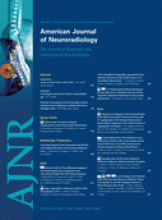Abstract
BACKGROUND AND PURPOSE: Cerebellar and brain stem atrophy are important features in SCA3, whereas SCA6 has been regarded as a “pure” cerebellar disease. However, recent neuropathologic studies have described additional brain stem involvement in SCA6. We, therefore, aimed to investigate the occurrence and impact of regional infratentorial brain volume differences in patients with SCA3 and SCA6.
MATERIALS AND METHODS: Thirty-four patients with genetically proved SCA (SCA3, n = 17; SCA6, n = 17) and age-matched healthy control subjects (n = 51) were included. In all subjects, high-resolution T1-weighted images were acquired with a 1.5T MR imaging scanner. Individual brain stem and cerebellar volumes were calculated by using semiautomated volumetry approaches. For all patients with SCA, clinical dysfunction was scored according to the ICARS. Multiple regression analysis was used to identify the contribution of regional volumes to explain the variance in clinical dysfunction in each SCA genotype.
RESULTS: Cerebellar volumes were lower in patients with SCA6 compared with controls and with those with SCA3. In contrast to controls, brain stem volume loss was observed in patients with SCA3 (P < .001) and, to a lesser extent, in those with SCA6 (P = .027). Significant linear dependencies were found between ICARS and cerebellum volume (SCA3: R2 = 0.29, P = .02; SCA6: R2 = 0.29, P = .03) and between ICARS and brain stem volume (SCA3: R2 = 0.49, P = .002; SCA6: R2 = 0.39, P < .01) in both subtypes. Both cerebellar and brain stem atrophy contributed independently to the variance in clinical dysfunction in SCA6, while in SCA3, only brain stem atrophy was of relevance.
CONCLUSIONS: Our current findings in accordance with recent neuroradiologic and pathoanatomic studies suggest brain stem and cerebellar volume loss as attractive surrogate markers of disease severity in SCA3 and SCA6.
Abbreviations
- B
- parameter estimates (coefficient B)
- CAG
- cytosine-adenine-guanine
- CI
- confidence interval
- 95% CI
- 95% confidence interval of B (Table 6)
- CNS
- central nervous system
- DD
- disease duration
- ICARS
- International Cooperative Ataxia Rating Scale
- GLM
- general linear model
- ICC
- intracranial capacity
- lntercept
- log odds (logit estimate)
- N.A.
- not applicable
- N.S.
- not significant
- OR
- odds ratio
- ρ
- correlation coefficient
- Ps.R2
- pseudo-R2 of the regression
- R2
- coefficient of determination
- RC
- repeatability coefficient
- SARA
- Scale for the Assessment and Rating of Ataxia
- SCA
- spinocerebellar ataxia
- Copyright © American Society of Neuroradiology












